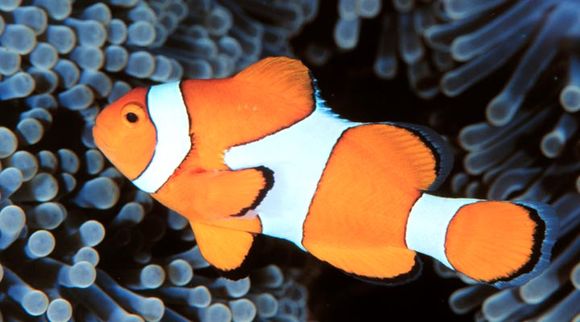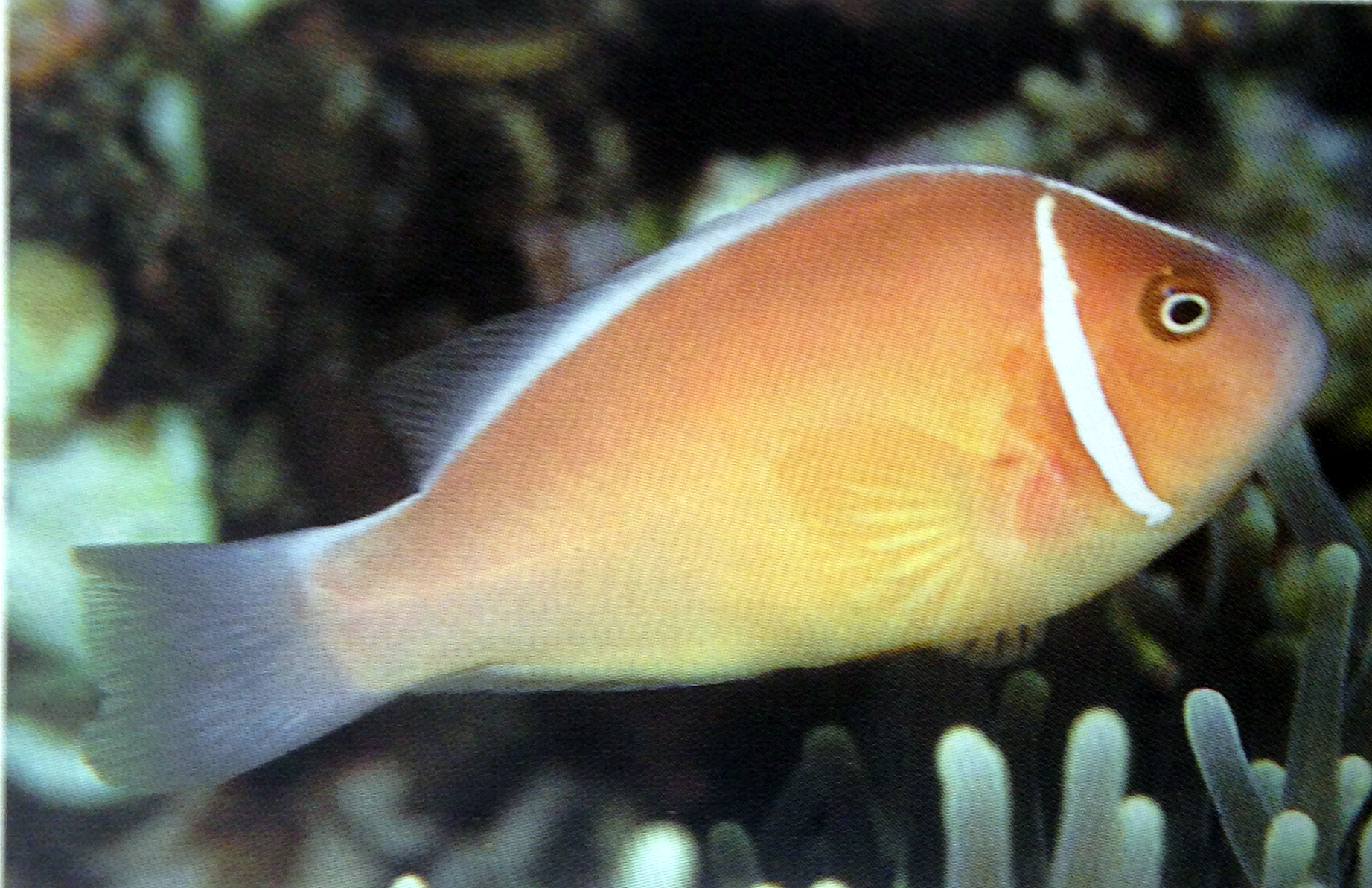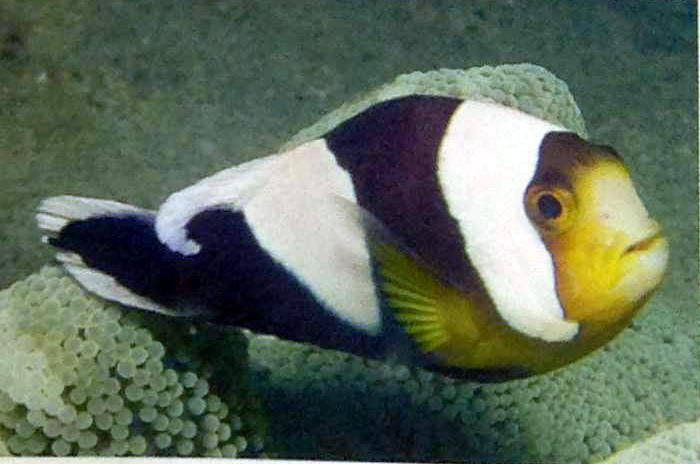False Clownfish
 |
| Amphiprion ocellaris at Sultan Shoal, Singapore (Image by Joy Wong) |
1. Have you ever spotted Nemo?
Did you know that the false clownfish Amphiprion ocellaris, star of the popular Disney Pixar film Finding Nemo can be found in Singapore? Perhaps one of the most enigmatic reef fish, everyone can identify the false clownfish at first glance. Bright orange and always swimming about near an anemone, it is relatively common and easy-to-spot for beginners to SCUBA diving as well. Besides the false clownfish, this species is also known as the false clown anemonefish, ocellaris clownfish, common clownfish, false percula clownfish and nemofish.
Table of Contents
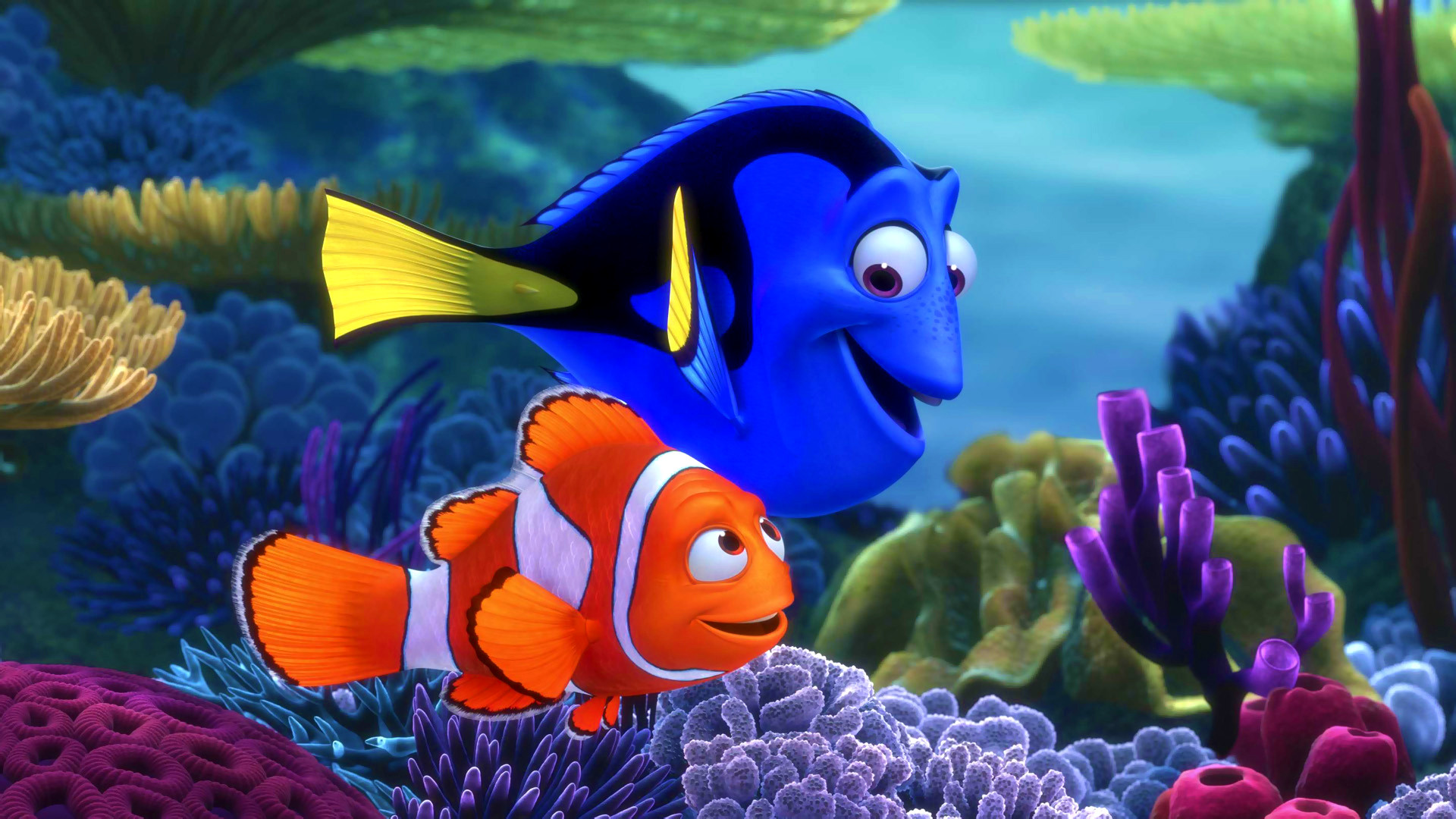 |
| Marlin and Dory from the popular Disney film Finding Nemo. Image from Buena Vista Pictures, permission pending. |
How much do you know about the false clownfish other than its fame from the popular animated film Finding Nemo and its sequel Finding Dory? This page aims to let everyone from kids to adults learn more about the false clownfish, with information unavailable in most generic pages about the false clownfish. You can find out interesting facts about its biology, distribution and related conservation issues in easy-to-digest or clearly explained terms. Keep a lookout for FUN FACT sections for snippets of information, such as what actually should have happened in the film. If you are feeling adventurous, also read on about its taxonomy, especially its relationship with its almost identical-looking sister species the true clownfish, as well as about its evolutionary relationship with other species of clownfishes.
FUN FACT! Did you know that the name Nemo comes from anemone, the species is associated with? Still don't get it? Here it is: aNEMOne!
2. What does its scientific name mean?
Scientific names are often derived from other languages and harbour some meaning to the name. The name of the genus Amphiprion comes from the Greek word "amphi" = "on both sides" and "prion" = saw, due to both sides of the head being indented like a saw. The name of the species ocellaris comes from the Latin "ocellus" = small eye, referring to the caudal (tail) pattern, as the specimen used to describe the species originally is likely a juvenile whose white band has not fully formed, resembling an eye on its tail.
3. Where can you find Nemo?
Clownfish are reef fishes, living in coral reefs and sheltered lagoons up to 15 m deep [1] . The most well-known fact about the clownfish is that it is associated with anemones, with which they have a mutualistic relationship, whereby both the anemone and the clownfish benefits from this relationship. In exchange for protection from predators, the clownfish helps remove parasites from the anemone and drives off intruders [2] . For more details about this unique relationship with the anemonefish, refer to the section on Symbiosis.
False clownfish living among anemone in the seas of Singapore. Video by Joy Wong.
In Singapore, the false clownfish is seen in large sea anemones, namely the Gigantic Sea Anemone (Stichodactyla gigantea) and the Magnificent Sea Anemone (Heteractis magnifica) which are found in intertidal areas and reefs along the Southern Islands [3] . Elsewhere, the false clownfish has also been recorded in the Mertens’ Sea Anemone (Stichodactyla mertensii).
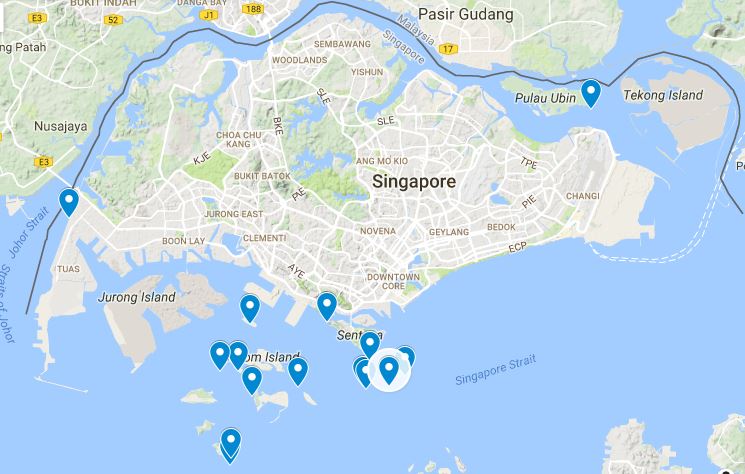 |
| Map showing the locations where the false clownfish has been recorded in Singapore. Image generated by Joy Wong with Google Maps. |
Its geographic distribution mainly centres around the Indo-West Pacific, ranging from the Andaman Sea in the east to the Philippines and north-western Australia in the west. It can be found northwards to the Ryukyu Islands in Japan. A rare black bodied variation is found in Darwin, Australia, while the orange variety is found elsewhere [4].
 |
| Black morph of the false clownfish found in Darwin, Australia. Image by ORA, used with permission. |
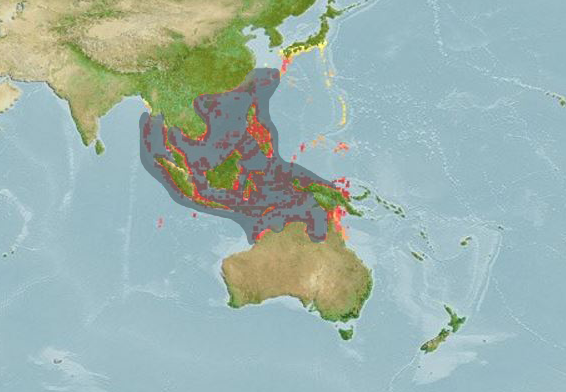 |
| Map of distribution of False Clownfish. Image adapted from Aquamaps, used under Creative Commons. |
4. Which of Nemo's close friends can you find in Singapore?
In Singapore, there are four other recorded species of clownfish besides the false clownfish (Amphiprion ocellaris), namely Clark's anemonefish (Amphiprion clarkii), the tomato anemonefish (Amphiprion frenatus), the saddleback anemonefish (Amphiprion polymnus) and the pink anemonefish (Amphiprion perideraion). These fish can be identified based on the number of bands around their body and colouration, as well as their host anemones. Here is a quick visual guide to help you tell your clownfishes apart! For a more scientific description of the false clownfish, refer to the section on Diagnosis below. For reliable descriptions and images of the anemone, please follow the links to pages from this Taxo4254 database, Wild Singapore and Hexacorallians of the World (H. aurora & H. malu).
| Image |
Common name |
Scientific name |
Description [4] |
Host anemone [5] |
||
|
False clown anemonefish |
Ampriprion ocellaris |
Orange with 3 white bands. Middle band has forward-projecting bulge. Bands and fins have variable amounts of black edging. |
Heteractis magnifica, Stichodactyla gigantea, Stichodactyla mertensii |
||
|
Clark's anemonefish |
Amphiprion clarkii |
Black with 2 white bands, white or yellow tail with abrupt boundary. Fins variably black to yellow-orange |
Heteractis magnifica, Heteractis crispa, Heteractis aurora, Heteractis malu, Entacmaea quadricolor, Stichodactyla gigantea, Stichodactyla mertensii, Stichodactyla haddoni, Macrodactyla doreensis, Cryptodendrum adhaesivum |
||
|
Tomato anemonefish |
Amphiprion frenatus |
Orange to red with single white or pale bluish head bar. Males considerably smaller than female. Females are primarily black on sides with red snout, breast, belly and fins. Juveniles have 2 to 3 white bars |
Entacmaea quadricolor |
||
|
Pink anemonefish |
Amphiprion perideraion |
Pink to orange; narrow white head bar, and white dorsal stripe from between eyes to tail |
Heteractis magnifica, Heteractis crispa, Stichodactyla gigantea, Macrodactyla doreensis |
||
|
Saddleback anemonefish |
Amphiprion polymnus |
Varying amounts of black to dark brown and yellow-orange, white head bar and broad somewhat forward slanting mid-body bar, white edging on black tail |
Stichodactyla haddoni, Heteractis magnifica, Heteractis crispa |
5. Biology
Symbiosis with Anemone
Clownfish are obligate associates of sea anemones, which means they require this symbiotic relationship with anemones to survive. Most anemonefish are poor swimmers, almost defenseless and depend on their sea anemone for defense [6] . The tentacles of sea anemones have nematocysts, or stinging cells, which they use to deter prey many species of fish and most invertebrates. By adapting to living with anemones, the clownfishes receive protection from its predators [7] . Watch the video below for footage of an anemone devouring a whole fish that unlike the clownfish, is not adapted to living with its stinging cells.Clownfish are not born with immunity to the stinging anemone. They perform an elaborate dance, exposing parts of their bodies to become accustomed to their host’s stinging tentacles. Using actions such as 'kissing', where an anemonefish nibbles or pushes the tentacles of a host, and 'bathing', when the fish rubs its abdomen with the tentacles [8] , the clownfish is eventually able to obtain a layer of mucus on the its body, making it immune to the anemone as it prevents the stinging cells from firing. Clownfish are also able to detect their hosts through chemical cues due to imprinting while it's in its nest [9] . This means that it rapidly learns to recognise their host when they are juveniles nesting near the anemone.
FUN FACT! More generalist species of clownfish, such as the Clark's anemonefish, aren't that picky with anemone species and seem to be able to generate their own mucus without having to acclimatise with the anemone [6].
Anemones attacking fishes. Video from YouTube, used under Standard YouTube licence.
However, this association with anemones are not solely in the clownfish’s benefit. An experiment conducted in the wild showed that anemones hosting clownfish have growth and survival rates that are significantly higher than that of anemones without clownfish. They are also able to undergo asexual reproduction at higher frequencies. The enhanced survival rate can be attributed to the protection the anemone receives from the clownfish, as clownfish would aggressively chase after butterflyfish and other predators of anemone which have been seen biting tentacles of their host anemone. Other than protection, clownfish also provide an added source of nitrogen through its excrement, which could be incredibly beneficial in the nitrogen-scarce coral reef ecosystem [4].
Social Hierarchy
Clownfish live in social groups where a size-based hierarchy exists. All clownfish are born males, and they progressive become larger according to the hierarchy they belong to. The oldest and largest in a group is always a reproducing female, and the second largest is a reproducing male. The other non-producing males get progressively smaller down the hierarchy. Therefore, a clownfish only becomes a female if it succeeds in queuing through the entire hierarchy in an anemone [10] .
They are monogamous fishes, and form a long-term bonding with their partners. As romantic as this sounds, this relationship may not be what you imagine as the largest female exerts aggressive dominance towards the top few dominant males to prevent them from changing sex from male to female. The males subsequently show aggression towards other males below them. The diagram below illustrates the hierarchical display of aggression in a clownfish group [11] .
FUN FACT! In Finding Nemo, Coral, Marlin's wife, would actually be quite domineering and aggressive towards Marlin, instead of the caring and loving relationship portrayed in the film.

FUN FACT! What actually should have happened in Finding Nemo was that Marlin would likely change his gender to become female, and Nemo would rise the ranks and become the reproducing male. Talk about the ultimate plot twist!
Reproduction
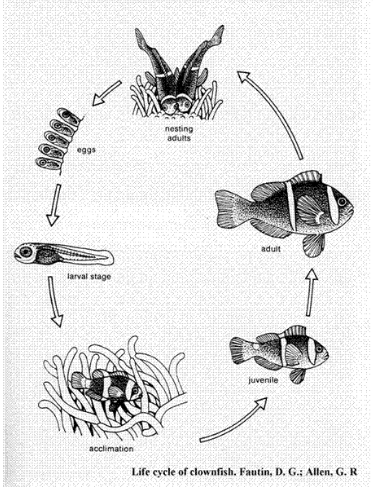 |
| Life cycle of clownfish. Image from Fautin and Allen [14]. |
When the male successfully chases the female to the nest, the female would begin the process of spawning. She passes the nest several times and lays the orange eggs on the prepared nest over a period of 1-2 hours before leaving the nest [14] . Eggs are 3-4 mm in diameter and range from 100 to 1000 depending on the age of the fish [15] . The male continues the spawning process by passing over and fertilising the eggs. Eggs are held onto the substrate by a fine thread, and the male cares for the eggs by fanning them with his fins to provide aeration.
Eggs of the saddleback clownfish, Amphiprion polymnus, in Anilao, Philippines. Male fanning behaviour can be clearly observed. Video from YouTube, used under Standard YouTube licence.
Incubation depends on the temperature of the water, cooler water would result in longer incubation time, but it generally takes 6-8 days before the eggs hatch [15]. The hatched larvae are planktonic and live in the surface of the water. It is at this stage where they are able to disperse for long distances since the adult clownfish does not travel further than a few metres from its anemone [16] . The larval stage lasts for 8-12 days. After which, the juvenile clownfish returns to the bottom and attempts to find an anemone to settle into [16]. However, this process is often difficult due to the aggression as mentioned in the previous section. Even if the settling clownfish can find a suitable host, many do not survive as they are chased away or killed by the clownfish already residing in the anemone [8].
Diet
The natural diet of the false clownfish comprises mainly plankton. They are omnivores, feeding on both copepods, algae and zooplankton [17] . They commonly feed in the vicinity of the anemone in the day and seek shelter in the tentacles of the anemone at night. Smaller clownfish usually do not stray far away from the protection of the anemone to look for food, while larger clownfish will forage at further distances from the anemone but generally no farther than several metres [5].6. Conservation and Threats
Commercial Interest
As these anemonefishes are so colourful and attractive, they often make for pretty exhibits in aquariums. With the commercial success of the film Finding Nemo, every child wanted a Nemo and Dory in their fish tank. The world’s largest fish hatchery in the world, Ocean, Reefs & Aquariums in Florida, saw a 40% increase in clownfish sales after the movie’s release [18] . Years afterwards, populations in the wild were still being affected as captive breeding programmes could not cope with soaring demand [19] . Furthermore, clownfish are prone to harvest from the wild as captive-bred clownfish cost more compared to wild-caught stocks [20].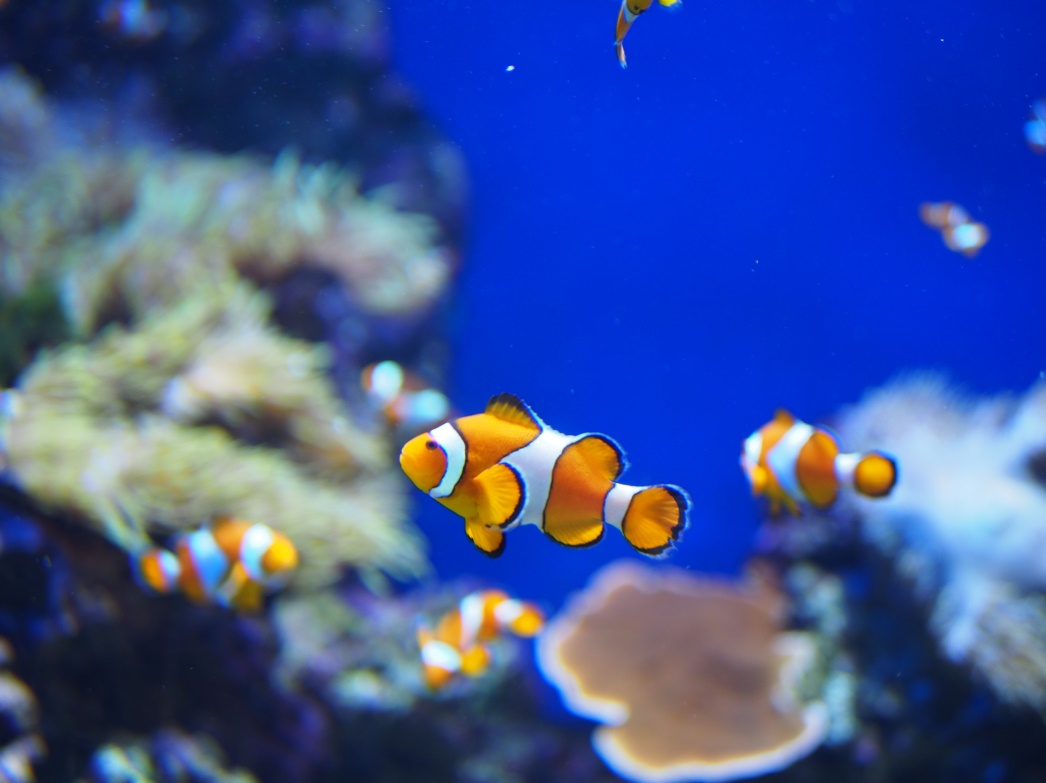 |
| Anemonefish at SEA Aquarium. Image by Joy Wong |
In Singapore, all five species of clownfish have been assessed to be Vulnerable, facing threats of habitat loss from land reclamation and uncontrolled collection of fish and anemones for aquarium trade[20] . While it has not been assessed by the IUCN (2016) for global data yet [21] , the false clownfish may face threats in the future due to habitat degradation as coral reefs are increasingly threatened due to issues including rising sea temperatures, sedimentation and pollution.
7. Taxonomy
The following part contains detailed taxonomic information, including the use of scientific terms and jargon. This section might be too technical and uninteresting for the average reader, so proceed with caution!
Taxonavigation
Kingdom AnimaliaPhylum Chordata
Class Actinopterygii
Order Perciformes
Family Pomacentridae
Genus Amphiprion
Species A. ocellaris Cuvier, 1830
Synonyms
Amphiprion bicolor Castelnau, 1873
Amphiprion melanurus Cuvier, 1830
Original Description
Translation from French:
Mr Valenciennes observed in the office of the Zoological Society of London a little amphiprion from Sumatra, similar to a Perchot (A. percula), but the bands are not lined with black. The caudal fin is lined with white, brown at the tip, and wears down a large white occelus. The pectoral fin is brown, with a white border. Its length is three quarters of an inch.
Diagnosis
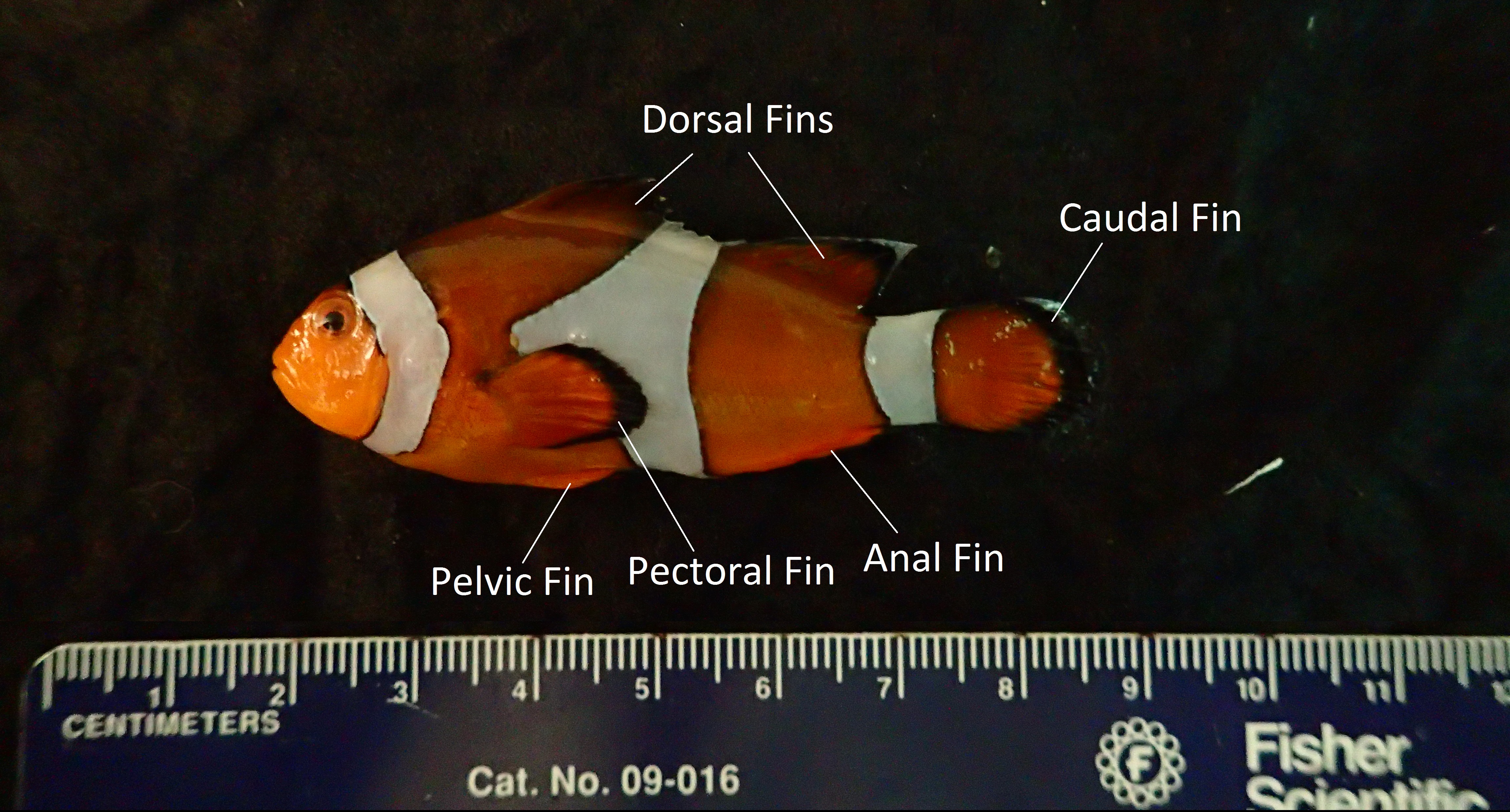 |
| A false clownfish. Image by Aden Ip, used with permission; annotations by Joy Wong. |
Amphiprion ocellaris are orange to reddish orange with three white bands on their bodies. The white bands as well as the finds are outlined with black. A variant with black instead of orange bodies can be found in Darwin, Australia [4]. The dorsal fin has 10-11 spines, and 11 spines are more common. Its anal fin has 2 spines and 11-13 soft rays, while its pectoral fin has 16-18 soft rays. The false clownfish also has a rounded caudal fin (tail).
Which is which, the true or false clownfish?
 |
 |
| False Clownfish Amphiprion ocellaris Image by Randall, J.E., used under CC-BY-NC licence |
True Clownfish Amphiprion percula Image by Randall, J.E., used under CC-BY-NC licence |
As most field guides to identifying clownfish indicate, the two species A. ocellaris and A. percula have more or less the same colour pattern although some A. percula individuals have larger black bands in its colouration [4, 16]. The two species are usually distinguished based on geographic location. The number of dorsal spines varies but still overlaps between them, with A. ocellaris having typically 11 spines and occasionally 10, and A. percula having typically 10 spines and occasionally 9. Such similar morphology reveals something interesting about the relationship between the two species.
FUN FACT! Fun facts are hard to come by when you venture into the sections about taxonomy, but here's one for you since you made it so far. The sea level drop during the last ice age about 12,000 years ago likely helped the false and the true clownfish to become two species as the seas in between them dried up. Look at the maps below for more details!
The species Amphiprion ocellaris and Amphiprion percula for the subgenus Actinicola, which is a species complex. Molecular data found that A. ocellaris and A. percula form a well-supported monophyletic clade and diverged relatively recently, around 1.7 - 7.2 million years ago [22] . There is a clear species boundary between the two species, as they are distinguished based on geographic location. However, mitochondrial DNA data from Timm et al. (2008) revealed that A. percula was found in the geographic region of A. ocellaris, as indicated by the map below, which means the distribution pattern proposed by Fautin and Allen may not be exactly accurate [16].
(a) Exposed land masses at present levels (tan) and at sea levels 60m below (green). (b) Exposed land mass at Last Glacial Maximum. Red annotation indicates area which separated ranges of A. percula and A. ocellaris. Refer to previous figure for range of each species. Figure from Ludt & Rocha, 2015[23] , permission pending; annotation by Joy Wong.
The species boundaries of the two species can be explained from the dropping of sea levels during the late Pliocene (5.3 - 2.58 mya) by 40m and more drastically in the Pleistocene glaciation (2.58 - 0.0117 mya) by 120m, which resulted in the drying up of the Sunda shelf. This isolated the species on the Indian Ocean, such as those nearer to the site labeled 'Pa' in the above diagram from the other side of the shelf. Such a divergence of marine animals was also shown for other species such as the mantis shrimp Haptosquilla pulchella, seastar species and giant clam Tridacna crocea [22].
8. Phylogeny
Various phylogenetic studies have been conducted for species within the subfamily Amphiprioninae (Perciformes: Pomacentridae), which contains all species of clownfish. While it is clear that the subfamily is monophyletic, the phylogenetic relationship between species is unclear [24] .
There are 2 genera in this subfamily, with 29 valid species in the genus Amphiprion and 1 species in Premnas. Based on morphology, it has been suggested that A. clarkii is the most ancestral as it is the most generalist, being able to live with up to 10 different species of host anemones, and are most similar to other pomacentrids with similar body shape and good swimming skills [25] .
The phylogenetic tree presented below is one of the most comprehensive trees based on molecular data from 23 out of the 30 species of clownfish[26]. It is drawn from the combined analyses of 1991 nucleotides (nt) from the three genes: mitochondrial cytochrome b gene, 16S ribosomal RNA mitochondrial region and first half of the mitochondrial control region [26]. Bayesian and maximum parsimony (MP) approaches were used as the optimality criteria for tree selection. The topology largely agrees with other molecular-based studies such as those by Elliot et al. [27] and Li et al. [24]. The tree is generally well supported for recent divergences, but not as strong for the intermediate divergences.
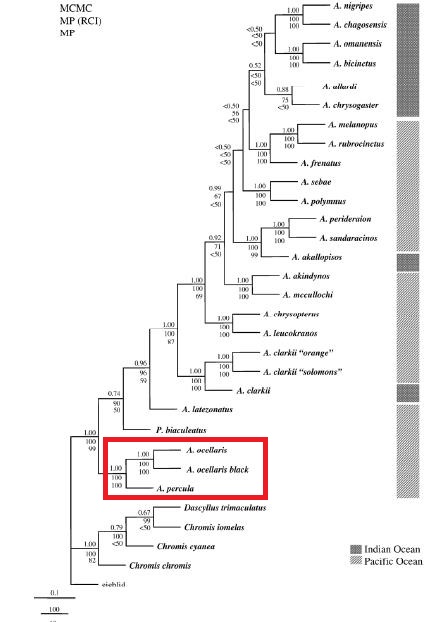
Contrary to what morphology suggests, the subgenus Actinola, comprising A. ocellaris and A. percula, together with Premnas biaculeatus has the most conserved molecular structure and forms the ancestral taxon of clownfishes. Another study which looked at 8 mitogenomes with many more base pairs (16,645 – 16,976 bp) of 8 species of clownfish belonging to Amphiprioninae found a similar result [24].
Multiple studies have indicated that the genus Amphiprion is not monophyletic as it contains the monotypic genus Premnas with a single species P. biaculeatus. However, as the both the genus Premnas and the members of the Actinicola subgenus are relatively far removed from the other clownfishes, the separation of the Premnas genus might not be warranted [26, 27].
9. References
Allen, G.R., R. Swainston, and J. Ruse, Marine Fishes of Tropical Australia and South-East Asia. 1997: Western Australian Museum.
Tan, R. Clown Anemonefish. 2013 [cited 2016 25-Oct]; Available from: http://www.wildsingapore.com/wildfacts/vertebrates/fish/pomacentridae/ocellaris.htm.
Mebs, D., Chemical biology of the mutualistic relationships of sea anemones with fish and crustaceans. Toxicon, 2009. 54.
Brolund, T.M., L.E. Nielsen, and M. Arvedlund, Do juvenile Amphiprion ocellaris (Pisces: Pomacentridae) recognize conspecifics by chemical or visual cues? Journal of the Marine Biological Association of the UK, 2003. 83(05): p. 1127-1136.
Buston, P.M. and M.B. García, An extraordinary life span estimate for the clown anemonefish Amphiprion percula. J Fish Biol, 2007. 70.
Fricke, H. and S. Fricke, Monogamy and sex change by aggressive dominance in coral reef fish. Nature, 1977. 266(5605): p. 830-832.
Buston, P., Social hierarchies: Size and growth modification in clownfish. Nature, 2003. 424(6945): p. 145-146.
Madhu, R., K. Madhu, and T. Retheesh, Life history pathways in false clown Amphiprion ocellaris Cuvier, 1830: A journey from egg to adult under captive condition. Journal of the Marine Biological Association of India, 2012. 54(1): p. 77-90.
Thresher, R.E., Reproduction in reef fishes. 1984.
Timm, J. and M. Kochzius, Geological history and oceanography of the Indo‐Malay Archipelago shape the genetic population structure in the false clown anemonefish (Amphiprion ocellaris). Molecular Ecology, 2008. 17(18): p. 3999-4014.
Sano, M., M. Shimizu, and Y. Nose, Food habits of teleostean reef fishes in Okinawa Island, southern Japan. 1984: University of Tokyo Press.
Gupta, S. Tropical Depression: Your Saltwater Fish Tank May Be Killing the Ocean. 2012 [cited 2016 23-Oct]; Available from: https://www.scientificamerican.com/article/tropical-depression-your-saltwater-fish-tank-may-be-killing-the-ocean/.
Timm, J., M. Figiel, and M. Kochzius, Contrasting patterns in species boundaries and evolution of anemonefishes (Amphiprioninae, Pomacentridae) in the centre of marine biodiversity. Molecular Phylogenetics and Evolution, 2008. 49(1): p. 268-276.
Li, J., et al., Mitochondrial DNA Genomes Organization and Phylogenetic Relationships Analysis of Eight Anemonefishes (Pomacentridae: Amphiprioninae). PloS one, 2015. 10(4): p. e0123894.
Allen, G.R., The anemonefishes: their classification and biology. 1975: T.F.H. Publications.
